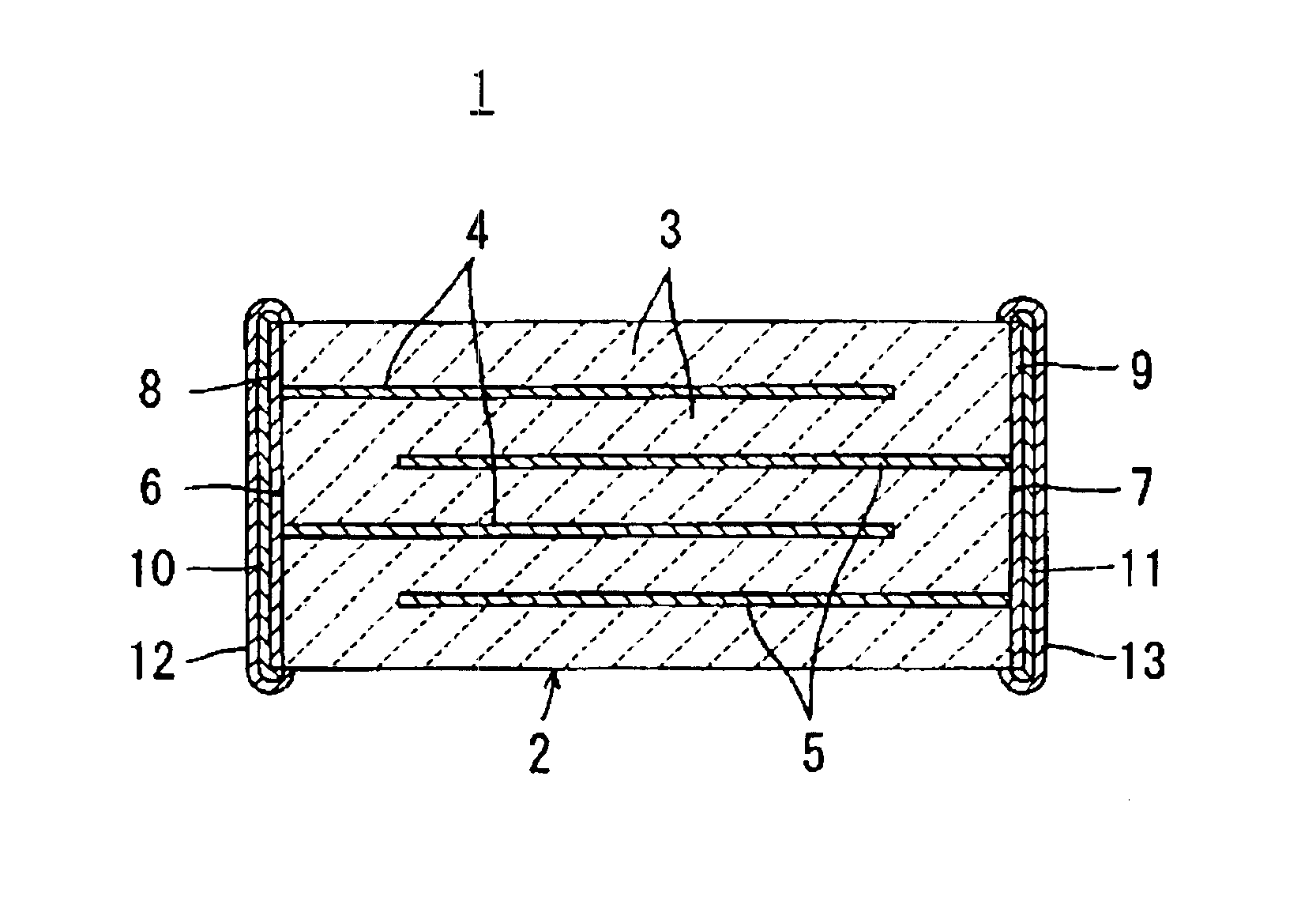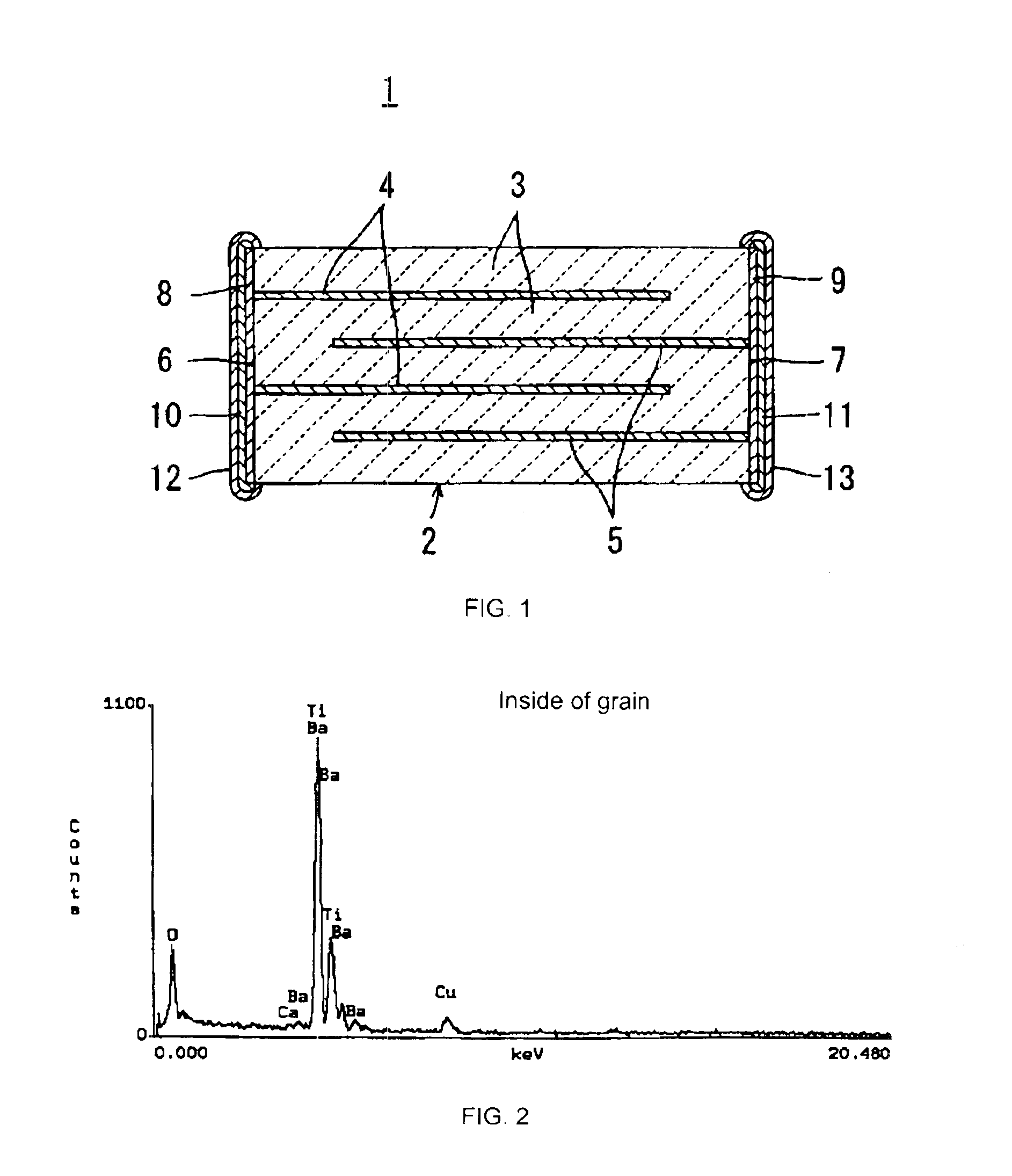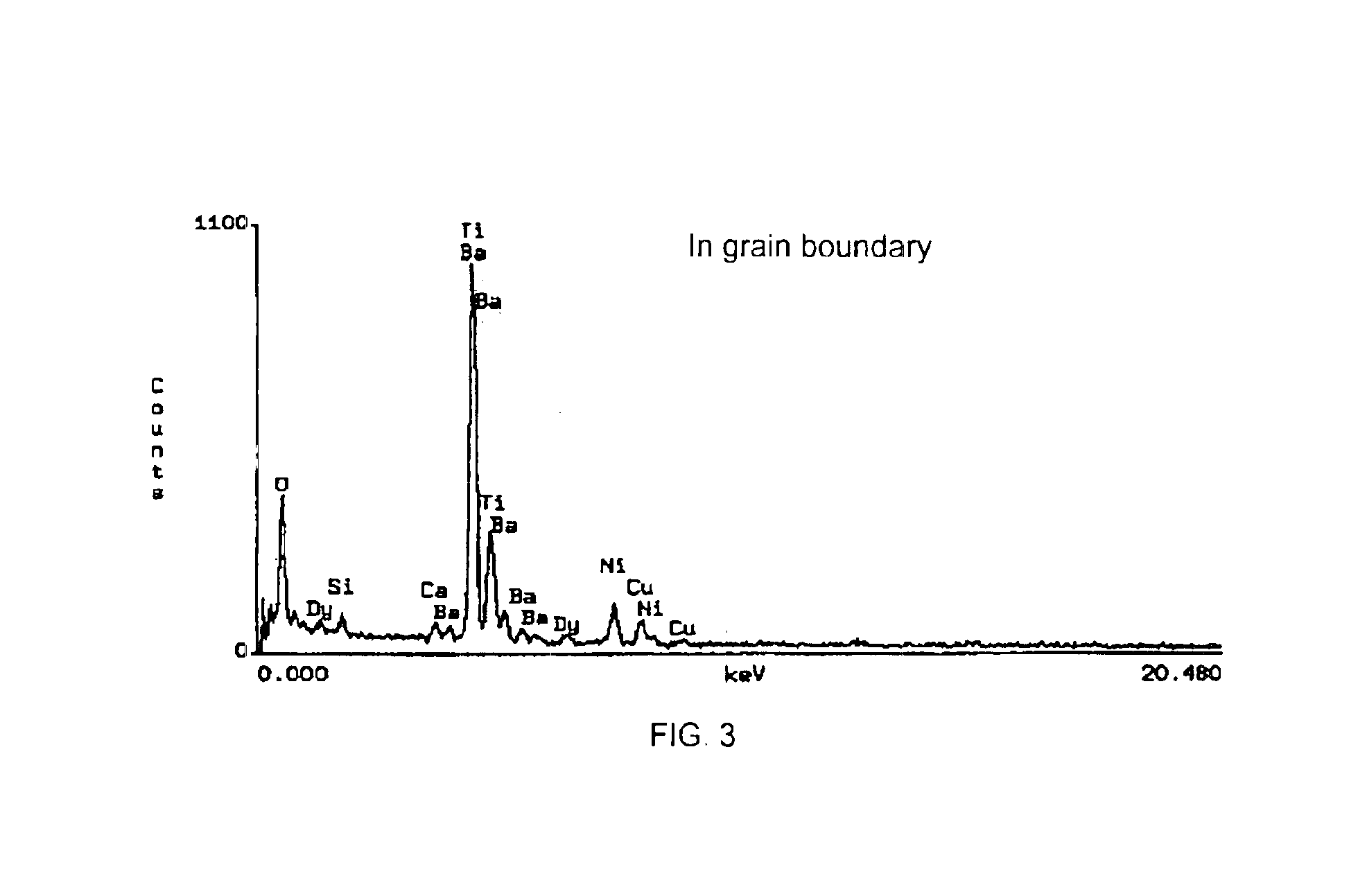Dielectric ceramic, method of producing the same, and monolithic ceramic capacitor
a monolithic ceramic and dielectric ceramic technology, applied in the field of dielectric, can solve the problems of reducing reliability, deteriorating capacitance temperature characteristics, and insufficiently meeting the demands of the market, and achieve the effect of enhancing reliability, easy and secure production
- Summary
- Abstract
- Description
- Claims
- Application Information
AI Technical Summary
Benefits of technology
Problems solved by technology
Method used
Image
Examples
experimental examples
Experimental Example 1
In Experimental Example 1, (Ba0.95Ca0.05)TiO3 was used as major component having the general formula ABO3, which contains Ba, Ca and Ti. As additive components, BaCO3, CaCO3, TiO2, SiO2, Dy2O3 and NiO were used, as shown in Table 1. Sample 1 as an embodiment of the present invention, and Samples 2-1 and 2-2 as comparative examples were evaluated.
1. Preparation of Powdery Dielectric Ceramic Raw Material
(1) Sample 1
First, BaCO3, CaCO3, and TiO2 were prepared as starting materials for the major component ABO3, and weighed out so that the composition of (Ba0.95Ca0.05)TiO3 could be produced. Subsequently, the raw materials were mixed for 72 hours with a ball mill and heat-treated at 1150° C. Thus, (Ba0.95Ca0.05)TiO3 was produced. The synthetic degree of this major component of ABO3 was evaluated based on the crystallographic axial ratio c / a of a tetragonal system. The axial ratio c / a was very high, i.e., 1.0101, as shown in Table 1. The average grain size was 0.3 μm...
experimental example 2
In Experimental Example 2, preferred ranges of the amounts of Ca and Ti in dielectric ceramics according to the present invention were determined. The ratio Cag / Tig and the ratio Cab / Tib in which Cag and Tig represent the amounts of Ca and Ti in crystal grains, and Cab and Tib represent the amounts of Ca and Ti in crystal grain boundaries (including a triple point), can be easily controlled by changing the ratio of the amounts of Ca and Ti, that is, the ratio Ca / Ti, in the major component raw material, and also, by changing the ratio the mounts of Ca and Ti, that is, the ratio Ca / Ti, in the additive component raw material.
Table 4 for Experimental Example 2 corresponds to Table 1 for Experimental Example 1. Table 4 shows the compositions and the crystallographic axial ratios c / a of the major components ABO3 and the compositions of calcined materials formed as the additive components in samples prepared in Experimental Example 2.
TABLE 4Crystallo-graphicSam-axial ratioplec / a of majornu...
experimental example 3
Experimental Example 3 was carried out to evaluate a preferred range of the concentration of Ca in crystal grains contained in the dielectric ceramic.
Table 6 corresponds to Table 1 for Experimental Example 1. Table 6 shows the compositions and the crystallographic axial ratio c / a of the major components ABO3 and the compositions of the calcined materials formed as the additive components in samples prepared in Experimental Example 3.
TABLE 6Crystallographicaxial ratio c / a ofSampleMajor componentmanor componentAdditive componentnumberABO3ABO3(calcined material)*11 100BaTiO31.00991.1Ba—0.2Ca—1.0Ti—1.4Si—1.0Dy—1.0Mn—0.5Ni—0.5Mg—O12100(Ba0.99Ca0.01)TiO31.01021.1Ba—0.2Ca—1.0Ti—1.4Si—1.0Dy—1.0Mn—0.5Ni—0.5Mg—O13100(Ba0.89Ca0.10Sr0.01)TiO31.00971.0Ba—0.1Ca—1.2Ti—1.2Si—1.0Dy—1.0Mn—0.5Ni—0.5Mg—O14100(Ba0.80Ca0.20)(Ti0.995Hf0.005)O31.00951.0Ba—0.1Ca—1.2Ti—1.2Si—1.0Dy—1.0Mn—0.5Ni—0.5Mg—O15100(Ba0.79Ca0.21)TiO31.00941.0Ba—0.2Ca—1.0Ti—1.4Si—1.0Dy—1.0Mn—0.5Ni—0.5Mg—O
As shown in Table 6, powdery die...
PUM
| Property | Measurement | Unit |
|---|---|---|
| thicknesses | aaaaa | aaaaa |
| thickness | aaaaa | aaaaa |
| thickness | aaaaa | aaaaa |
Abstract
Description
Claims
Application Information
 Login to View More
Login to View More - R&D
- Intellectual Property
- Life Sciences
- Materials
- Tech Scout
- Unparalleled Data Quality
- Higher Quality Content
- 60% Fewer Hallucinations
Browse by: Latest US Patents, China's latest patents, Technical Efficacy Thesaurus, Application Domain, Technology Topic, Popular Technical Reports.
© 2025 PatSnap. All rights reserved.Legal|Privacy policy|Modern Slavery Act Transparency Statement|Sitemap|About US| Contact US: help@patsnap.com



